Travel vlogging has become a popular way for adventurers to share their experiences. Every year, camera technology advances, offering better options for capturing high-quality videos and photos during trips. As we delve into this adventure, we will explore the best travel vlogging cameras available in 2023, focusing on performance, ease of use, and portability.
Aspiring travel vloggers search for compact cameras and essential features such as wide focal length, good stabilization, and a front-facing flip screen. The ideal camera should be able to handle diverse shooting conditions while providing stunning image quality and battery life to cover a day’s worth of sightseeing.
We will review the top recommended travel vlogging cameras, including the Canon PowerShot G7X Mark III, Sony ZV-1, Sony ZV-E10, and more. With our guidance, you will be well-equipped to decide which camera is best suited for your travel vlogging needs in 2023.
Table of Contents
Best Compact Cameras for Travel Vlogging
This section will discuss three top compact cameras for travel vlogging: Sony ZV-1, DJI Pocket 2, and Fujifilm X-E4. These cameras provide excellent video quality, portability, and features that make them ideal choices for travel vloggers.
Sony ZV-1

The Sony ZV-1 is a popular choice for travel vlogging due to its compact size and powerful video capabilities. Key features of the Sony ZV-1 include:
- 1-inch sensor, ensuring good video quality even in low-light conditions
- Fast autofocus with Real-time Eye Autofocus and Real-time Tracking for smooth video capture
- 4K video recording at 30fps and Full HD at 120fps for slow-motion capabilities
- Directional 3-capsule microphone for improved audio recording, with a windscreen included
With a built-in Vari-angle LCD screen and a comfortable grip, the Sony ZV-1 makes capturing stunning videos on your travels easy.
DJI Pocket 2

The DJI Pocket 2 stands out among compact travel vlogging cameras with its 3-axis gimbal, providing stable and smooth footage even while moving. Important features of the DJI Pocket 2 are:
- 1/1.7-inch sensor for better low-light performance compared to its predecessor
- 4K video recording at 60fps, offering high-quality footage
- 8x zoom feature for versatility in capturing different scenes
- Modular design with a detachable base, allowing for various accessories like a tripod, external microphone, or wireless module
The DJI Pocket 2’s portability and stabilization technology make it a fantastic option for capturing stabilized videos on the go.
Fujifilm X-E4

The Fujifilm X-E4 is a compact mirrorless camera that may appeal to those looking for a stylish design and interchangeable lens system for travel vlogging. Highlights of the Fujifilm X-E4 include:
- Large APS-C sensor for excellent video image quality
- 4K video recording at 30fps and Full HD at 240fps for slow-motion capabilities
- Variety of film simulation modes for a unique, cinematic look
- Compact and lightweight design for comfortable use during long travel days
By offering superb video quality, customizable features, and a wide selection of lenses, the Fujifilm X-E4 is an attractive choice for travel vloggers who want a versatile camera for their adventures.
Top Mirrorless Cameras for Travel Vlogging
Sony α7C
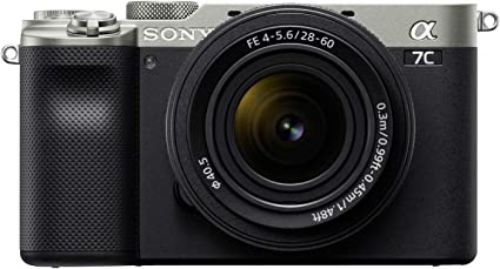
The Sony α7C is a compact and lightweight mirrorless camera, making it ideal for travel vlogging. It features a full-frame 24.2MP Exmor R CMOS sensor and BIONZ X image processor, resulting in excellent image quality and low-light performance. The 5-axis in-body image stabilization helps reduce camera shake for smoother video recording. Key features of the α7C include:
- 4K video recording at 30fps
- Fast hybrid AF system with 693 phase-detection points and 425 contrast-detection points
- Side-opening vari-angle touchscreen LCD
- External microphone input and headphone output for improved audio quality
Olympus OM-D E-M5 Mark III

The Olympus OM-D E-M5 Mark III is an advanced mirrorless camera with powerful features packed into a compact body. Designed for travel vloggers, it is known for its robust image stabilization and high-resolution video capabilities. Some notable features are:
- 20MP Micro Four Thirds Live MOS Sensor
- 5-axis in-body image stabilization with up to 6.5 stops of compensation
- 4K video recording at 30fps with various bitrates to choose from
- Fully articulating touchscreen LCD for easy self-monitoring
Canon EOS M50 Mark II

The Canon EOS M50 Mark II is a versatile and affordable mirrorless camera, perfect for travel vloggers on a budget. It features a 24.1MP APS-C CMOS sensor and DIGIC 8 image processor, providing good image quality and low-light performance. Some important features include:
- 4K video recording at 24fps
- Dual Pixel CMOS AF system with Eye Detection AF
- Vari-angle touchscreen LCD
- Integrated microphone input for better audio quality
Fujifilm X-T30 II
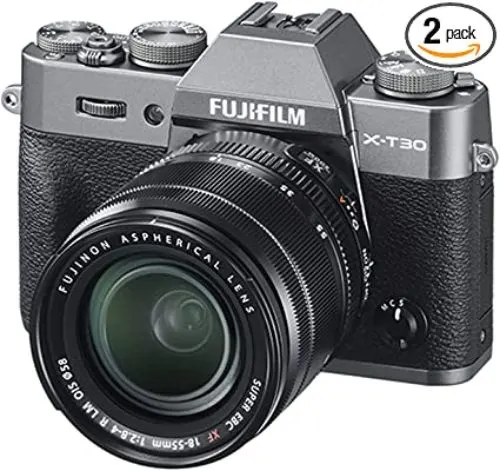
The Fujifilm X-T30 II is a stylish and compact mirrorless camera offering impressive performance and user-friendly functions. Its excellent image quality, due to its 26.1MP APS-C X-Trans CMOS 4 sensor, makes it an attractive option for travel vloggers. A few key features are:
- 4K video recording at 30fps
- Hybrid AF system with 425 phase-detection points
- 3.0-inch 1.04M-dot tilting touchscreen display
- Fujifilm’s renowned film simulation modes for creative video looks
Overall, these four mirrorless cameras offer a fantastic combination of portability, performance, and features, making them perfect choices for travel vlogging.
Best Action/Adventure Cameras for Travel Vlogging
GoPro Hero 10 Black
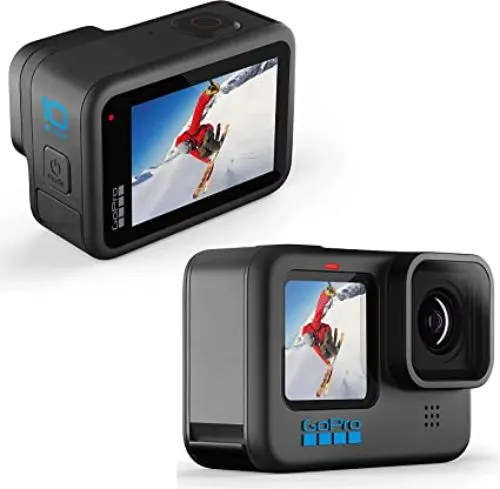
The GoPro Hero 10 Black is an excellent choice for travel vloggers who are into action and adventure. This camera offers:
- 5.3K video resolution for stunning clarity and detail
- A wide range of frame rates for slow-motion and time-lapse footage
- Hypersmooth 4.0 stabilization for smooth video capture even in extreme conditions
- Waterproof design up to 33ft (10m) without a housing
For vloggers willing to create amazing content with a durable and reliable action camera, the GoPro Hero 10 Black is a solid choice.
GoPro Hero 11 Black
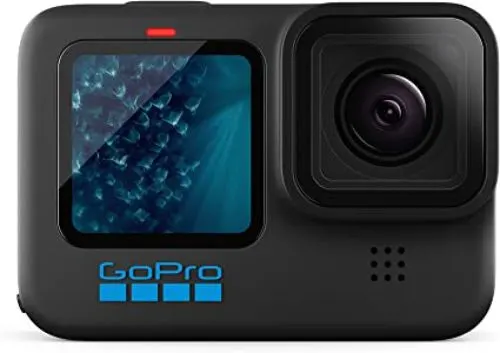
Though not yet released, the GoPro Hero 11 Black is rumored to be the next action camera from GoPro. You might want to hold off purchasing a GoPro Hero 10 Black and watch announcements regarding the Hero 11 Black.
Olympus Tough TG-6

For adventurous travelers who prefer a more traditional camera form factor, the Olympus Tough TG-6 is a great option. It offers:
- 12 MP, 1/2.3″ sensor for excellent image quality
- 4K video recording at 30fps
- High-speed movie mode for slow-motion footage
- Built-in GPS and Wi-Fi for easy location tagging and sharing
- Waterproof, shockproof, freezeproof, and crushproof design
For a rugged camera that can handle extreme conditions while maintaining excellent image and video quality, the Olympus Tough TG-6 is a top choice for travel vloggers focused on action and adventure.
hy a Vlogging Camera is Essential for Traveling

Portability
A crucial aspect of travel vlogging is portability. When constantly on the move, carrying heavy and bulky equipment is not ideal; having a lightweight and compact vlogging camera is crucial. For instance, mirrorless cameras offer an excellent balance of portability and performance, allowing you to effortlessly capture high-quality video and images without straining yourself during the journey.
Sony a6600 with the Tamron 11-20mm F2.8 is a great choice for a lightweight and compact vlogging camera that offers the flexibility of an interchangeable lens.
Versatility
When traveling, you’ll come across various environments and situations, so a versatile camera is essential for adapting to these ever-changing scenarios. Interchangeable lenses provide the flexibility to switch between different focal lengths and aperture settings, allowing you to capture various types of shots—from close-ups to wide-angle scenes.
Moreover, cameras like the Canon EOS M50 are a budget-friendly option that allows for interchangeable lenses, making it perfect for travel vlogging.
Image Quality
Capturing high-quality footage is crucial for travel vlogging. A front-facing camera with a wide enough focal length is a must-have feature in a vlogging camera. Advanced cameras like the Canon EOS 5D Mark IV or the Fujifilm X-S10 ensure sharp images even in low-light situations, enhancing the overall quality of your vlog.
Furthermore, adequate image resolution, varying from Full HD to 4K, ensures you deliver crisp and detailed videos.
Battery Life
Long battery life is an essential factor when traveling. With limited access to power sources throughout the day, you’ll want a vlogging camera with a reliable battery life to document your experiences without interruptions.
Cameras like the Canon PowerShot G7X Mark III, known for its reliable battery life, are a great option for travel vloggers, ensuring you have ample power for all your filming needs. By choosing a vlogging camera that excels in portability, versatility, image quality, and battery life, you can fully focus on sharing your travel adventures with the world without the added hassle of cumbersome equipment and poor-quality footage.
Key Features to Consider
When selecting the best travel vlogging camera, it’s essential to focus on crucial features that will enhance your video quality and adapt to various situations. It’s also essential to maintain a balance between a camera’s performance, cost, and maximum weight you have to carry. In this section, we’ll discuss key features you should consider when choosing your perfect travel vlogging camera.
Image Stabilization
One of the essential aspects of a good vlogging camera is image stabilization. Image stabilization helps in achieving smooth, professional-looking videos, especially when shooting handheld or on the go. There are two main types of image stabilization:
- In-Body Image Stabilization (IBIS): The camera itself stabilizes the image sensor to counteract camera movement. This allows you to use any compatible lens and still get stable footage.
- Lens-based stabilization: Some lenses come with built-in stabilization, which compensates for camera shake while shooting handheld. However, this relies on the lens being used and may not be available in all lens options.
It is best to have a camera that supports both types of stabilization for optimal versatility.
Autofocus System
Achieving sharp focus is vital in vlogging. Cameras have different autofocus systems, so it’s essential to choose one that performs well in various lighting conditions and can quickly focus on subjects as they move in front of the camera. Look for a camera with fast and accurate autofocus capabilities, ideally with advanced features such as face and eye detection.
Lens Options
A flexible, high-quality lens is one of the fundamentals that sets a camera apart for travel vlogging. Keep in mind the following factors when considering lens options:
- Wide-angle lenses: These are ideal for capturing entire scenes or creating a sense of depth in your footage. Aim for a focal length of around 16-24mm for the best results.
- Interchangeable lens: A camera with interchangeable lenses allows you to switch lens options for different shooting scenarios. This flexibility enables you to experiment with different focal lengths, apertures, and styles, so that you get professional results in a range of situations.
See Related: Best Games to Play on a Bus for Entertaining Group Travel
Built-in Microphone
While many travel vloggers prefer using an external microphone for better sound quality, a built-in microphone is still an important feature to consider. A camera with a good built-in microphone can save you from carrying additional accessories, reducing the overall weight of your equipment.
It also makes it easier to capture spontaneous moments on-the-go without needing to set up external gear. Look for a camera with a built-in microphone with clear and crisp sound quality, and consider investing in external accessories like a windshield to minimize wind noise.
Comparing Sensors: Full-Frame vs APS-C vs Micro Four Thirds
This section will delve into the differences between Full-Frame, APS-C, and Micro Four Thirds sensors commonly used in travel vlogging cameras.
Full-Frame Sensor
A full-frame sensor is the standard and has no crop factor. It is modeled after the 35mm film format; therefore, it’s known for its larger size than APS-C and Micro Four Thirds sensors. This size difference provides several advantages:
- Larger pixels, enabling better low-light performance
- Shallower depth of field for better subject isolation
- Wider field of view, as it doesn’t need crop factor adjustments
However, full-frame sensors typically result in larger and heavier cameras, which might not be ideal for travel vlogging.
APS-C Sensor
An APS-C (Advanced Photo System type-C) sensor, also known as a crop sensor, has a crop factor of 1.5x (on Nikon and Sony cameras) or 1.6x (on Canon cameras). This crop factor affects the field of view and the equivalent focal length of lenses. Cameras with APS-C sensors are usually more compact and lightweight, making them suitable for travel vlogging. Some key aspects of APS-C sensors include:
- Smaller sensor size than full-frame (around 1.6 times smaller)
- Good balance between low-light performance and camera size
- Crop factor needs to be considered when selecting lenses
Micro Four Thirds Sensor
The Micro Four Thirds sensor is smaller, with a crop factor of 2x. This means that the lens’s focal length needs to be multiplied by 2 to get the equivalent focal length on a full-frame camera. Micro Four Thirds cameras are typically small and portable, perfect for travel vlogging. Here are some essential points to consider about Micro Four Thirds sensors:
- Smaller sensor size than both full-frame and APS-C (about 2 times smaller than APS-C)
- Generally better depth of field control, but less low-light performance
- Increased portability, with a compact body and lens system
See Related: Best Travel Trailers to Live in Full-Time & For Nomads
Additional Accessories and Tips for Travel Vloggers
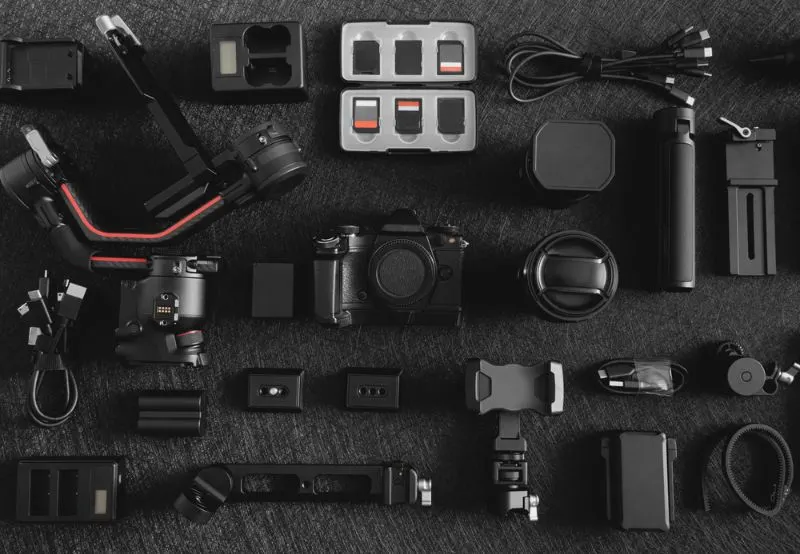
Gimbals and Stabilizers
Gimbals and stabilizers are essential accessories for travel vloggers, as they help ensure smooth, shake-free footage while on the go. Investing in a quality gimbal or stabilizer can significantly improve the overall quality of your travel videos. Some popular options for vloggers include:
- DJI Ronin-S: A versatile, professional gimbal designed for DSLRs and mirrorless cameras.
- Zhiyun Weebill S: A compact and lightweight gimbal suitable for various camera setups.
- GoPro Karma Grip: An excellent stabilizer for GoPro cameras, perfect for action-packed adventures.
Interchangeable Lenses
The ability to switch between different lenses can greatly enhance the versatility of your travel vlogging setup. By having a range of lenses available, you can achieve various effects, from wide-angle shots to capturing details in low light conditions. Some popular lenses for travel vlogging include:
- Tamron 11-20mm F/2.8: A wide-angle zoom lens that’s perfect for landscape and architectural shots.
- Fuji 16mm F1.4 XF: A fast prime lens ideal for low-light environments and creative depth-of-field effects.
- Sigma 16mm F1.4 DC DN: A versatile lens suitable for a variety of situations, such as street and portrait photography.
Smartphone Integration
In today’s fast-paced, digital world, travel vloggers must be able to integrate their smartphones with their camera gear. This allows for easy sharing and editing of content on the go. There are several accessories available that can help bridge the gap between your smartphone and camera:
- Tripod mounts: Attach your smartphone to a tripod to create stable and professional-looking footage.
- Remote shutter controls: Use your smartphone as a wireless remote to control your camera’s settings and start or stop recordings.
- Mobile editing apps: Take advantage of apps like Adobe Premiere Rush or LumaFusion to edit and share your travel videos directly from your smartphone.
By eqipping yourself with a quality gimbal or stabilizer, a set of interchangeable lenses, and smartphone integration tools, you can elevate your travel vlogging game and create captivating content for your audience. Be sure to choose accessories that fit your specific camera setup and adapt to your unique travel experiences.
Conclusion
In summary, the top travel vlogging cameras of 2023 are designed to meet various needs and budgets. Some standout options include the Canon PowerShot G7X Mark III, Sony ZV-1, Sony ZV-E10, and Fujifilm X-S10. These cameras offer a balance of image quality, stabilization, and features useful for travel vloggers.
| Camera Model | Key Features |
|---|---|
| Canon G7X Mark III | Popular choice, upgraded from G7X Mark II, suitable for all trips |
| Sony ZV-1 | Great point-and-shoot camera with a focus on video |
| Sony ZV-E10 | Interchangeable lens camera tailored for vloggers |
| Fujifilm X-S10 | Compact, lightweight, and versatile mirrorless camera |
When selecting a travel vlogging camera, it is essential to consider key factors such as wide focal length, good stabilization, and front-facing flip screens. These features not only improve overall usability but also streamline the vlogging process.
Finally, it’s essential to remember that the camera’s value lies in its ability to create engaging and informative content. Even the most advanced camera cannot compensate for low-quality content. Focus on capturing experiences that resonate with your audience and enhance your storytelling abilities to create compelling travel vlogs.
Related Resources:
